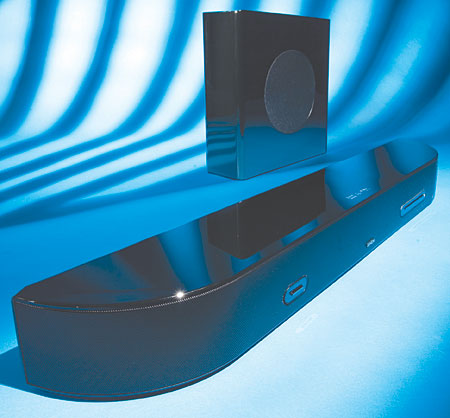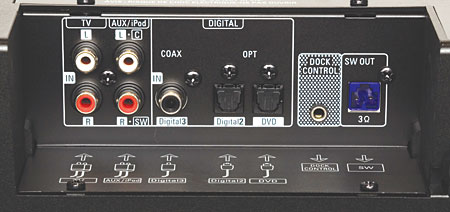The Power of One: Five Soundbar Speaker Systems Denon DHT-FS3
Like the Philips soundbar, the DHT-FS3 is a proprietary system that includes both the soundbar and subwoofer. Boasting the smallest footprint in the group, the soundbar is less than 34 inches wide and 4 inches tall, and the sub is about the size and shape of an entry-level A/V receiver. Both have an attractive, gloss-black finish, but everyone felt that the soundbar’s front-panel display, which flashes “Stereo” or “Surround” in large block letters, brought down the overall aesthetic. Johnny likened it to a clock radio. The supplied remote lacks backlighting but has a clean, intuitive layout, and you can program it to control a TV, DVD player, and cable/satellite box, although oddly, no manufacturer codes are listed in the manual.

This time, the amplification for the speaker’s six 3.2-inch drivers and the subwoofer’s single 6.3-inch woofer is housed in the speaker cabinet. Setup is very simple. Just connect the speaker and sub via a proprietary cable, connect your sources to the speaker’s input panel, and plug the speaker cabinet into a wall outlet. The soundbar comes with wall-mount brackets and two types of screw-in feet of different heights, so you can potentially set it up straddling the base of a flat panel, which is smart thinking on Denon’s part. The proprietary cable is only about 10 feet long; it’s basically just speaker wire with snap-on connectors, so you can switch in a longer cable if necessary. The input panel includes three digital inputs (two optical, one coaxial), two stereo analog inputs, and a control port for use with Denon’s $129 ASD-1R iPod dock; the unit lacks HDMI or any other type of video passthrough.

Using the Quick Setup feature, you can easily shuffle between three default room configurations, with preset options for room size, soundbar placement, movie or music preference, and amount of reflectivity. Or, if you prefer, you can go into the Setup menu and adjust each parameter independently. Other setup options include bass and treble controls (–12 to +12 decibels), a Fader control to tailor the surrounds’ level based on movies or music, and a lip-sync control. Because this is a closed system, you can’t adjust individual channel levels, but I did use the bass control to try to match the subwoofer level with the rest of the system. During a general level check of each channel, I found that the center channel was voiced about 3 to 4 dB higher than the other channels, which would prove to be meaningful. The DHT-FS3 has only three sound- format options—stereo, wide stereo, and surround (for Dolby Pro Logic II, Dolby Digital, and DTS).
 As we moved through the demo material, an interesting dichotomy emerged. Since I was the Face Off moderator, I spent most of my time in the back of the room and off to the side, while the participants moved around in the main sweet-spot areas. I came away from the demo being generally impressed by DHT-FS3. It couldn’t produce as full a midrange as the Marantz or the deeper bass of the outboard Polk subwoofer. Still, its dynamic ability was solid for such a small system, its sound didn’t have an overly
processed quality, and I was pleased with its surround simulation. The three participants agreed with those sentiments, but their notes were also littered with phrases like “in your face,” “upfront,” and “harsh.” Dano summed it up with, “Me no likey the highs!”
As we moved through the demo material, an interesting dichotomy emerged. Since I was the Face Off moderator, I spent most of my time in the back of the room and off to the side, while the participants moved around in the main sweet-spot areas. I came away from the demo being generally impressed by DHT-FS3. It couldn’t produce as full a midrange as the Marantz or the deeper bass of the outboard Polk subwoofer. Still, its dynamic ability was solid for such a small system, its sound didn’t have an overly
processed quality, and I was pleased with its surround simulation. The three participants agreed with those sentiments, but their notes were also littered with phrases like “in your face,” “upfront,” and “harsh.” Dano summed it up with, “Me no likey the highs!”
When I later moved to the sweet spot, I immediately understood what they were talking about. The center channel, set to be several decibels higher, has a focused, beaming quality that affects the overall presentation when you sit front and center. This effectively keeps the vocals from being pushed back into the mix (as we heard with other systems), and high-frequency effects are crisp and defined, but they break up at higher volume levels. Music was much smoother in stereo than in Dolby Pro Logic II, and the movie demos were fatiguing at higher volumes. I experimented with the limited sound controls at my disposal and found that setting the DHT-FS3 for a Type 3 room, which is a bigger space with softer reverb, and turning down the treble control a few notches eased this upfront quality and made for a more enjoyable experience. Also, sitting to the side of the center channel made that beaming quality less noticeable.
Another benefit to moving off-axis was that Denon’s X-Space Surround technology was more effective. Both Dano and I commented that we could hear more distinct surround effects when we sat closer to the walls along which the sounds were traveling. Even in the center position, the system creates a believable sense of envelopment with minimal tweaking required, although again, effects are generally to the sides and not the rear. Johnny felt that the Lord of the Rings surround effects were much better at the higher wall placement, while Scott preferred lower placement.
While the subwoofer couldn’t render the deepest low-frequency effects and rumble in movie soundtracks, I liked its ability to produce defined, controlled bass notes with music and felt it did a solid overall job with all but the deepest LFE effects. All three men felt that the systems that used the non-proprietary subwoofer had a bit more meat in the lower midrange and bottom end.
The Denon’s performance drew diverse opinions: Scott and I ranked it second, while Johnny and Dano ranked it fourth because of the center-channel issue. However, when considering the whole package of price, aesthetics, setup, and features, the DHT-FS3 landed firmly in second place, as most everyone felt it strikes a nice balance between all of the elements that the general consumer will appreciate.
- Log in or register to post comments






























































